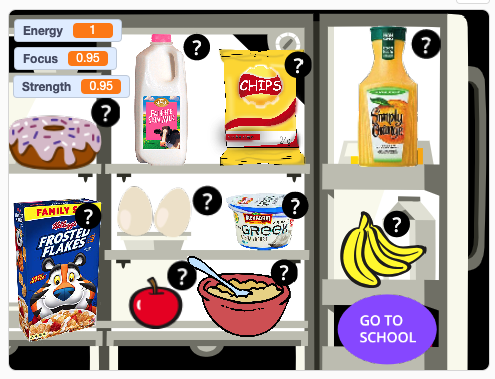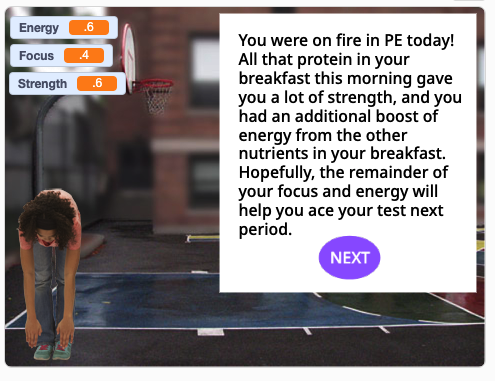Group members: Lilian Eix, Amy Vogel, Shikun Zhu

The data say that each and every food is different according to its nutritional makeup. We want to tell this story because each nutrient contributes to one’s well-being in a different way; though we often think of making food choices based on budgeting calories, a different (and perhaps healthier) attitude to instill in kids is to think of food as fuel to help them accelerate in their daily activities. To do so, we used data from the USDA Food Composition Database.
Our audience is middle schoolers, who are typically thinking about nutrition and body image seriously for the first time, as they are going through puberty. When learning about nutrition, kids are often taught about roughly how many calories they should eat per day, about balancing the different food groups, that certain foods are “unhealthy”/”bad,” and that other foods are “healthy”/”good.”
Our goals are to create a game that would teach kids about nutrition in a more positive light and to emphasize the importance of a healthy breakfast. In our game, while some foods are certainly more “fuel efficient” than others, more importantly, different types of “fuel” will help the character with different types of activities. The player (a middle school student) can select what their character will eat for breakfast, and then see how the character performs throughout a typical school day.
We didn’t want kids to get in the habit of obsessing over numbers, so we intentionally hid the nutrition facts from the game screen (though in a final version we would also supply the user with the option to learn more about the nutrition information if they wanted to). Instead, the nutrition facts are indirectly communicated through the user’s strength, energy, and focus levels. Through formulas based on nutritional science, we used the protein, carbohydrates, and sugar content from our selected foods to determine how much strength, energy, and focus each food would contribute to the character. After breakfast, the character bikes to school, attends class, goes to P.E., and then takes a test. In each of those four activities, their strength, energy, and focus levels determine how well they will do. At the end of the game, the user has the opportunity to play again, which is crucial, because repetition is how they will learn the effect of different food choices.

Link to game: https://scratch.mit.edu/projects/304291992/